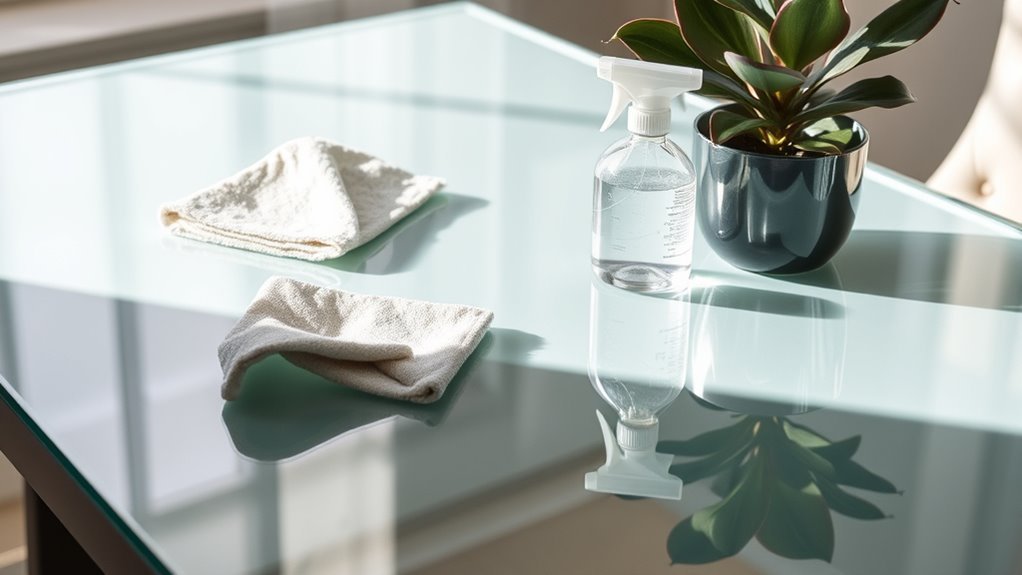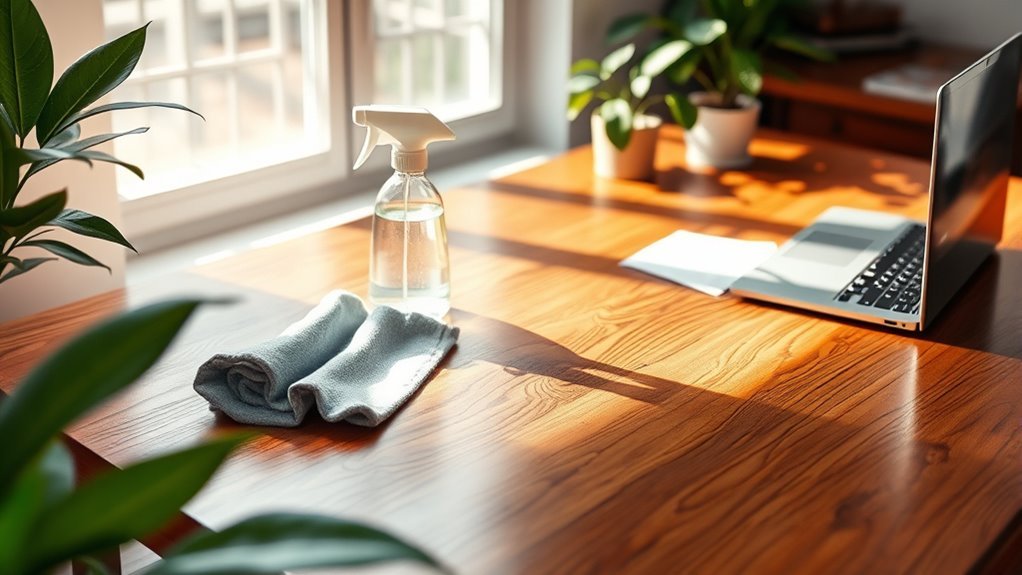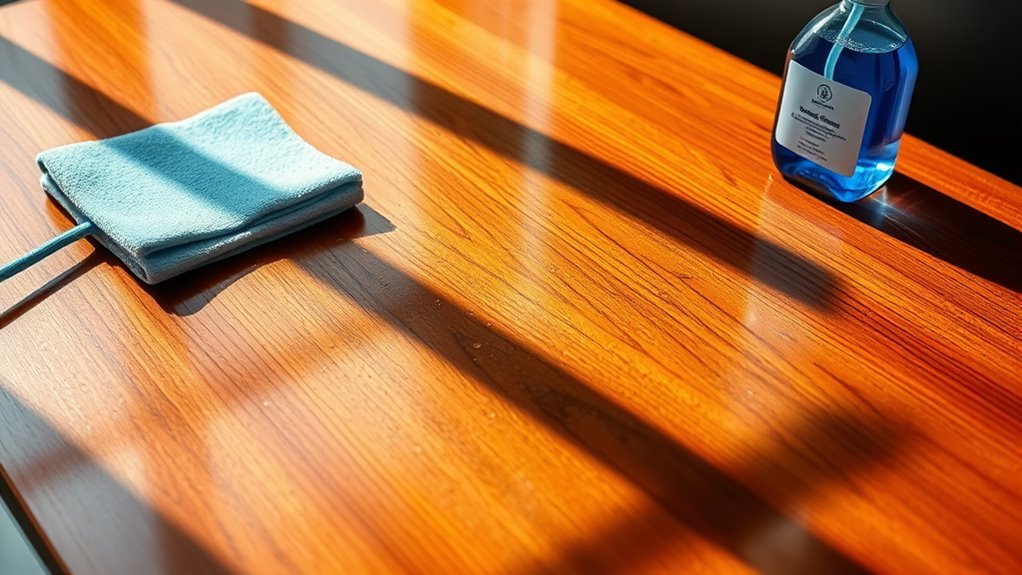Washing Desk Without Damage
To wash your desk without causing damage, first identify its material—wood, glass, or metal—to choose a suitable, mild cleaner like pH-neutral soap or a vinegar-water mix for glass. Always use soft microfiber cloths to avoid scratches, dampen them slightly rather than soaking, and dry surfaces immediately to prevent moisture harm. Avoid harsh chemicals like bleach or ammonia unless recommended. Organizing items reduces accidental scrapes. If you want to guarantee every surface stays pristine, there are careful methods tailored just for your desk type.
Choosing the Right Cleaning Products for Different Desk Materials

When you’re selecting cleaning products for your desk, it’s crucial to contemplate the material to avoid damage. Different desk materials—such as glass, metal, laminate, or plastic—respond uniquely to various cleaning solutions. Using abrasive cleaners on delicate surfaces can lead to scratches or discoloration. You’ll want to choose pH-neutral, non-abrasive cleaning solutions for sensitive materials, while more durable surfaces might tolerate stronger agents. Always check the product label and test any cleaning solution on a small, inconspicuous area first. Avoid bleach or ammonia-based cleaners unless specifically recommended, as they can degrade finishes or coatings. By carefully matching cleaning solutions to your desk materials, you guarantee effective cleaning without compromising the integrity or appearance of your workspace, preserving both function and freedom in your environment.
Step-by-Step Guide to Cleaning Wooden Desks Safely
Because wooden desks require gentle care to maintain their finish and structural integrity, it’s essential to follow a careful cleaning process. Start by dusting your desk with a soft, dry microfiber cloth to remove loose dirt. Next, mix a small amount of mild soap with warm water. Dampen a clean cloth with this solution—avoid soaking it—and gently wipe the surface. Use a second cloth dampened with plain water to remove any soap residue. Dry the desk immediately with a soft, dry towel to prevent moisture damage. For wooden desk care, avoid harsh chemicals and abrasive cleaning tools that can scratch or strip the finish. Regular, gentle cleaning with the right tools preserves both the beauty and durability of your wooden desk.
Effective Techniques for Cleaning Glass Desk Surfaces

Although glass desks are generally easier to clean than wooden ones, you’ll still need to use careful techniques to avoid streaks and scratches. Start by dusting the surface with a soft microfiber cloth to remove loose debris. For glass cleaning, mix equal parts distilled water and white vinegar in a spray bottle—this solution effectively cuts grease without harsh chemicals. Lightly mist the surface and wipe in a circular motion, then finish with vertical strokes to prevent streaking. Avoid abrasive sponges or paper towels, as they can compromise surface protection by causing micro-scratches. Always dry the glass thoroughly to maintain its clarity and shine. By following these steps, you’ll keep your glass desk pristine while preserving the freedom of a spotless, damage-free workspace.
How to Maintain and Clean Metal Desk Frames
Keeping your glass desk surface spotless is only part of maintaining your workspace’s overall appearance. Metal frame maintenance is equally important to guarantee longevity and a clean look. Start by dusting the frame regularly with a soft cloth to prevent dirt buildup. For deeper cleaning, use a mild detergent diluted in water, applying it carefully with a non-abrasive sponge. Avoid harsh chemicals that can damage the metal coating. After cleaning, always dry the frame thoroughly to prevent moisture accumulation, which can lead to rust. For rust prevention, consider applying a light coat of protective wax or a specialized rust inhibitor, especially if your desk is in a humid environment. By following these steps cautiously, you’ll keep your metal desk frame durable and visually appealing without restricting your freedom to enjoy your workspace.
Tips for Preventing Damage While Regularly Cleaning Your Desk

When you clean your desk regularly, taking precautions to prevent damage is essential to preserve its finish and functionality. You should balance cleaning frequency with careful desk organization to avoid scratches and stains. Use gentle cleaning agents and soft cloths, and always test products on a small area first. Avoid excessive moisture and harsh chemicals that can degrade surfaces. Here’s a quick guide to help you maintain your desk safely:
| Tip | Reason |
|---|---|
| Use microfiber cloth | Prevents scratches |
| Limit cleaning frequency | Avoids wear from over-cleaning |
| Organize desk items | Reduces accidental damage |
| Use mild cleaning agents | Protects finish integrity |
| Dry immediately | Prevents water damage |
Follow these tips, and you’ll keep your desk both clean and undamaged, letting you enjoy freedom in your workspace.
Frequently Asked Questions
Can I Use Vinegar to Clean My Desk?
Imagine the fresh zing of vinegar as it cuts through grime, revealing your desk’s true shine. You can use vinegar to clean your desk, but be cautious—it’s best for sealed surfaces like glass or laminate. Vinegar benefits include natural disinfecting and streak-free cleaning, yet it might damage wood or delicate finishes. Always test a small spot first to protect your desk surfaces, ensuring your freedom to clean without worry.
How Often Should I Deep Clean My Desk?
For effective desk maintenance, you should deep clean your desk about once a month. This cleaning frequency helps prevent buildup of dust, grime, and germs, ensuring your workspace stays fresh and inviting. If you use your desk heavily or eat at it often, consider deep cleaning every two weeks. Being cautious with cleaning products and methods preserves your desk’s surface, giving you the freedom to work comfortably without worrying about damage.
Are Microfiber Cloths Safe for All Desk Surfaces?
Microfiber cloths offer great microfiber benefits, like trapping dust and being gentle, making them generally safe for most desk surfaces. However, you should still be cautious, as some delicate finishes or untreated wood might get scratched or dulled. Always test on a small, hidden area first to verify compatibility. Using microfiber cloths carefully lets you clean efficiently while protecting your desk’s look, giving you freedom to maintain it without worry.
What Should I Do About Sticky Residue on My Desk?
Oh, sticky residue on your desk—just what you wanted, right? To tackle it without harming your desk materials, start by testing a small, hidden spot with a gentle cleaner, like diluted dish soap or rubbing alcohol. Avoid harsh chemicals that could damage the finish. Use a soft cloth and gently rub, then wipe with a damp cloth. Patience and caution will keep your desk looking great while freeing it from that pesky stickiness.
Can Cleaning My Desk Improve My Productivity?
Cleaning your desk can definitely boost your productivity. When you maintain desk organization, it reduces distractions and helps you focus on tasks more efficiently. Plus, improving workspace aesthetics creates a pleasant environment, which can positively influence your mood and motivation. However, be cautious not to overclean or reorganize too often, as that might disrupt your workflow. Keeping a tidy, visually appealing space supports freedom in your work by making it easier to find what you need quickly.






